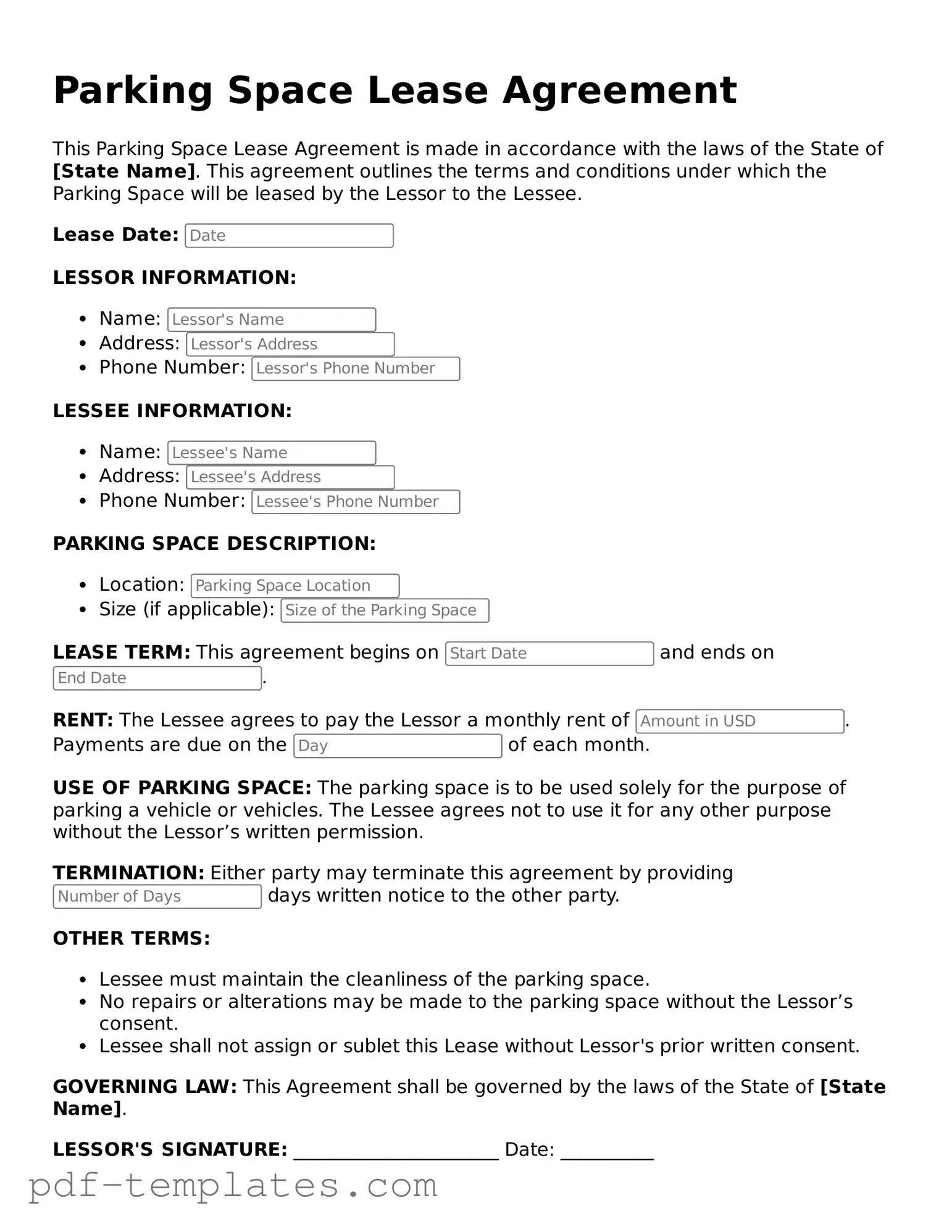The Parking Space Lease Agreement is similar to a Residential Lease Agreement. Both documents outline the terms under which one party (the tenant) can use property owned by another party (the landlord). They specify the duration of the lease, rental payments, and responsibilities of each party. While a Residential Lease Agreement typically pertains to living spaces, the Parking Space Lease Agreement focuses specifically on the rental of a parking space, making it a more niche version of the broader residential leasing framework.
Another document that shares similarities is the Commercial Lease Agreement. Like the Parking Space Lease Agreement, this document governs the rental of a specific space, but it is typically used for business purposes. Both agreements detail the terms of use, payment schedules, and conditions under which the lease can be terminated. The Commercial Lease Agreement may include additional clauses related to business operations, while the Parking Space Lease Agreement remains focused on parking rights.
The Storage Unit Lease Agreement is also comparable to the Parking Space Lease Agreement. Both forms serve to outline the terms for renting a designated space, whether it be for vehicles or personal belongings. Each agreement includes essential details such as rental fees, duration, and the responsibilities of the lessee and lessor. The Storage Unit Lease Agreement may contain specific terms related to access and security that are less relevant in a parking context.
In addition, the Boat Slip Lease Agreement shares similarities with the Parking Space Lease Agreement. Both documents allow individuals to lease a specific area for the storage of vehicles—one for cars and the other for boats. They outline the rental terms, payment obligations, and conditions for use. The Boat Slip Lease Agreement may also address unique aspects related to water access and safety regulations, which are not applicable in a parking scenario.
The RV Lot Lease Agreement is another document that aligns closely with the Parking Space Lease Agreement. Both agreements provide the framework for renting a designated area for vehicles, with the RV Lot Lease specifically catering to recreational vehicles. They include similar elements such as lease duration, payment terms, and maintenance responsibilities, but the RV Lot Lease may also incorporate additional clauses regarding utilities and access to amenities.
The Office Space Lease Agreement is also akin to the Parking Space Lease Agreement. Each document outlines the terms for renting a specific area, whether for parking or office use. They both define the responsibilities of the tenant and landlord, including payment schedules and maintenance obligations. However, the Office Space Lease Agreement often contains more extensive provisions related to business operations and shared facilities.
Another related document is the Equipment Rental Agreement. While not focused on space, this agreement similarly establishes the terms for the temporary use of property. Both documents specify the duration of use, payment terms, and responsibilities for damages or maintenance. The Equipment Rental Agreement is typically more technical, detailing the specific equipment being rented, whereas the Parking Space Lease Agreement centers on parking rights.
When navigating the various types of lease agreements, it's essential to acknowledge the California Lease Agreement form, which provides a comprehensive framework for landlord and tenant relationships. This legal document ensures clarity on terms such as rent, maintenance duties, and lease duration, thereby safeguarding both parties' interests. For those looking to establish a solid foundation for their rental arrangement, utilizing the California Lease Agreement form can be beneficial; you can find it at pdftemplates.info/california-lease-agreement-form.
Lastly, the Land Lease Agreement is comparable to the Parking Space Lease Agreement in that both outline the terms for leasing land for specific purposes. While the Land Lease Agreement may cover larger parcels for agricultural or commercial use, the Parking Space Lease Agreement is a focused version detailing the rental of a small, designated area for parking. Both agreements include terms related to duration, payment, and responsibilities, ensuring clarity for both parties involved.
